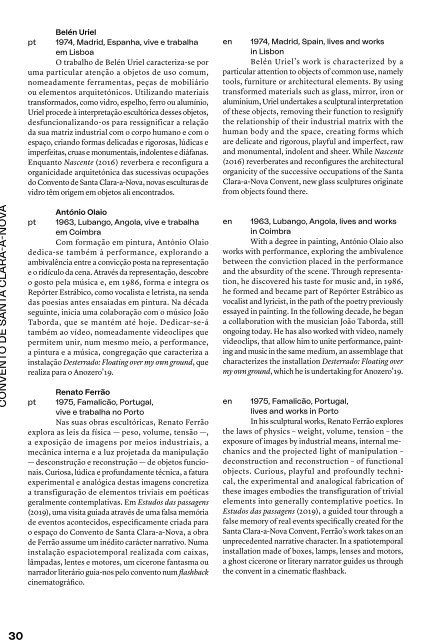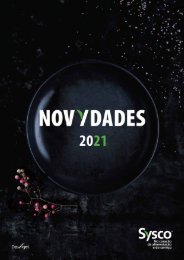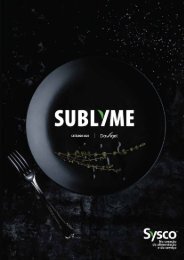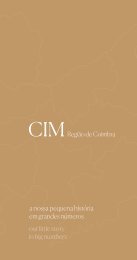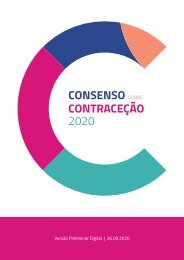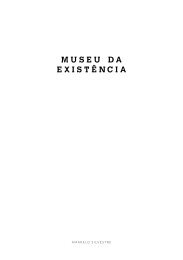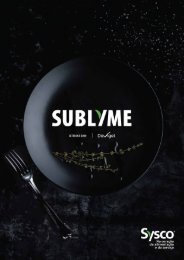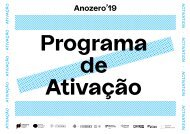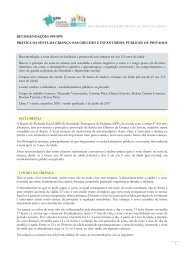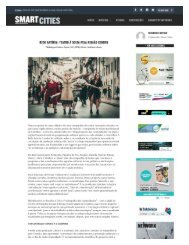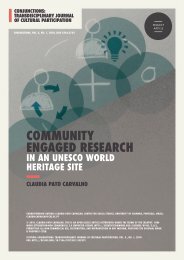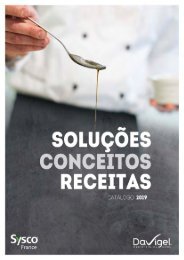Anozero'19 Bienal de Coimbra — A Terceira Margem / The Third Bank
O Anozero – Bienal de Arte Contemporânea de Coimbra nasceu de um esforço conjunto entre o Círculo de Artes Plásticas de Coimbra, a Universidade de Coimbra a e a Câmara Municipal de Coimbra, e tem, para a sua terceira edição, curadoria-geral de Agnaldo Farias e curadoria-adjunta de Lígia Afonso e Nuno de Brito Rocha.
O Anozero – Bienal de Arte Contemporânea de Coimbra nasceu de um esforço conjunto entre o Círculo de Artes Plásticas de Coimbra, a Universidade de Coimbra a e a Câmara Municipal de Coimbra, e tem, para a sua terceira edição, curadoria-geral de Agnaldo Farias e curadoria-adjunta de Lígia Afonso e Nuno de Brito Rocha.
You also want an ePaper? Increase the reach of your titles
YUMPU automatically turns print PDFs into web optimized ePapers that Google loves.
30<br />
convento <strong>de</strong> santa clara-a-nova<br />
Belén Uriel<br />
pt 1974, Madrid, Espanha, vive e trabalha<br />
em Lisboa<br />
O trabalho <strong>de</strong> Belén Uriel caracteriza-se por<br />
uma particular atenção a objetos <strong>de</strong> uso comum,<br />
nomeadamente ferramentas, peças <strong>de</strong> mobiliário<br />
ou elementos arquitetónicos. Utilizando materiais<br />
transformados, como vidro, espelho, ferro ou alumínio,<br />
Uriel proce<strong>de</strong> à interpretação escultórica <strong>de</strong>sses objetos,<br />
<strong>de</strong>sfuncionalizando-os para ressignificar a relação<br />
da sua matriz industrial com o corpo humano e com o<br />
espaço, criando formas <strong>de</strong>licadas e rigorosas, lúdicas e<br />
imperfeitas, cruas e monumentais, indolentes e diáfanas.<br />
Enquanto Nascente (2016) reverbera e reconfigura a<br />
organicida<strong>de</strong> arquitetónica das sucessivas ocupações<br />
do Convento <strong>de</strong> Santa Clara-a-Nova, novas esculturas <strong>de</strong><br />
vidro têm origem em objetos ali encontrados.<br />
António Olaio<br />
pt 1963, Lubango, Angola, vive e trabalha<br />
em <strong>Coimbra</strong><br />
Com formação em pintura, António Olaio<br />
<strong>de</strong>dica-se também à performance, explorando a<br />
ambivalência entre a convicção posta na representação<br />
e o ridículo da cena. Através da representação, <strong>de</strong>scobre<br />
o gosto pela música e, em 1986, forma e integra os<br />
Repórter Estrábico, como vocalista e letrista, na senda<br />
das poesias antes ensaiadas em pintura. Na década<br />
seguinte, inicia uma colaboração com o músico João<br />
Taborda, que se mantém até hoje. Dedicar-se-á<br />
também ao ví<strong>de</strong>o, nomeadamente vi<strong>de</strong>oclipes que<br />
permitem unir, num mesmo meio, a performance,<br />
a pintura e a música, congregação que caracteriza a<br />
instalação Desterrado: Floating over my own ground, que<br />
realiza para o Anozero’19.<br />
Renato Ferrão<br />
pt 1975, Famalicão, Portugal,<br />
vive e trabalha no Porto<br />
Nas suas obras escultóricas, Renato Ferrão<br />
explora as leis da física <strong>—</strong> peso, volume, tensão <strong>—</strong>,<br />
a exposição <strong>de</strong> imagens por meios industriais, a<br />
mecânica interna e a luz projetada da manipulação<br />
<strong>—</strong> <strong>de</strong>sconstrução e reconstrução <strong>—</strong> <strong>de</strong> objetos funcionais.<br />
Curiosa, lúdica e profundamente técnica, a fatura<br />
experimental e analógica <strong>de</strong>stas imagens concretiza<br />
a transfiguração <strong>de</strong> elementos triviais em poéticas<br />
geralmente contemplativas. Em Estudos das passagens<br />
(2019), uma visita guiada através <strong>de</strong> uma falsa memória<br />
<strong>de</strong> eventos acontecidos, especificamente criada para<br />
o espaço do Convento <strong>de</strong> Santa Clara-a-Nova, a obra<br />
<strong>de</strong> Ferrão assume um inédito carácter narrativo. Numa<br />
instalação espaciotemporal realizada com caixas,<br />
lâmpadas, lentes e motores, um cicerone fantasma ou<br />
narrador literário guia-nos pelo convento num flashback<br />
cinematográfico.<br />
en 1974, Madrid, Spain, lives and works<br />
in Lisbon<br />
Belén Uriel’s work is characterized by a<br />
particular attention to objects of common use, namely<br />
tools, furniture or architectural elements. By using<br />
transformed materials such as glass, mirror, iron or<br />
aluminium, Uriel un<strong>de</strong>rtakes a sculptural interpretation<br />
of these objects, removing their function to resignify<br />
the relationship of their industrial matrix with the<br />
human body and the space, creating forms which<br />
are <strong>de</strong>licate and rigorous, playful and imperfect, raw<br />
and monumental, indolent and sheer. While Nascente<br />
(2016) reverberates and reconfigures the architectural<br />
organicity of the successive occupations of the Santa<br />
Clara-a-Nova Convent, new glass sculptures originate<br />
from objects found there.<br />
en 1963, Lubango, Angola, lives and works<br />
in <strong>Coimbra</strong><br />
With a <strong>de</strong>gree in painting, António Olaio also<br />
works with performance, exploring the ambivalence<br />
between the conviction placed in the performance<br />
and the absurdity of the scene. Through representation,<br />
he discovered his taste for music and, in 1986,<br />
he formed and became part of Repórter Estrábico as<br />
vocalist and lyricist, in the path of the poetry previously<br />
essayed in painting. In the following <strong>de</strong>ca<strong>de</strong>, he began<br />
a collaboration with the musician João Taborda, still<br />
ongoing today. He has also worked with vi<strong>de</strong>o, namely<br />
vi<strong>de</strong>oclips, that allow him to unite performance, painting<br />
and music in the same medium, an assemblage that<br />
characterizes the installation Desterrado: Floating over<br />
my own ground, which he is un<strong>de</strong>rtaking for Anozero’19.<br />
en 1975, Famalicão, Portugal,<br />
lives and works in Porto<br />
In his sculptural works, Renato Ferrão explores<br />
the laws of physics – weight, volume, tension – the<br />
exposure of images by industrial means, internal mechanics<br />
and the projected light of manipulation –<br />
<strong>de</strong>construction and reconstruction – of functional<br />
objects. Curious, playful and profoundly technical,<br />
the experimental and analogical fabrication of<br />
these images embodies the transfiguration of trivial<br />
elements into generally contemplative poetics. In<br />
Estudos das passagens (2019), a gui<strong>de</strong>d tour through a<br />
false memory of real events specifically created for the<br />
Santa Clara-a-Nova Convent, Ferrão’s work takes on an<br />
unprece<strong>de</strong>nted narrative character. In a spatiotemporal<br />
installation ma<strong>de</strong> of boxes, lamps, lenses and motors,<br />
a ghost cicerone or literary narrator gui<strong>de</strong>s us through<br />
the convent in a cinematic flashback.


